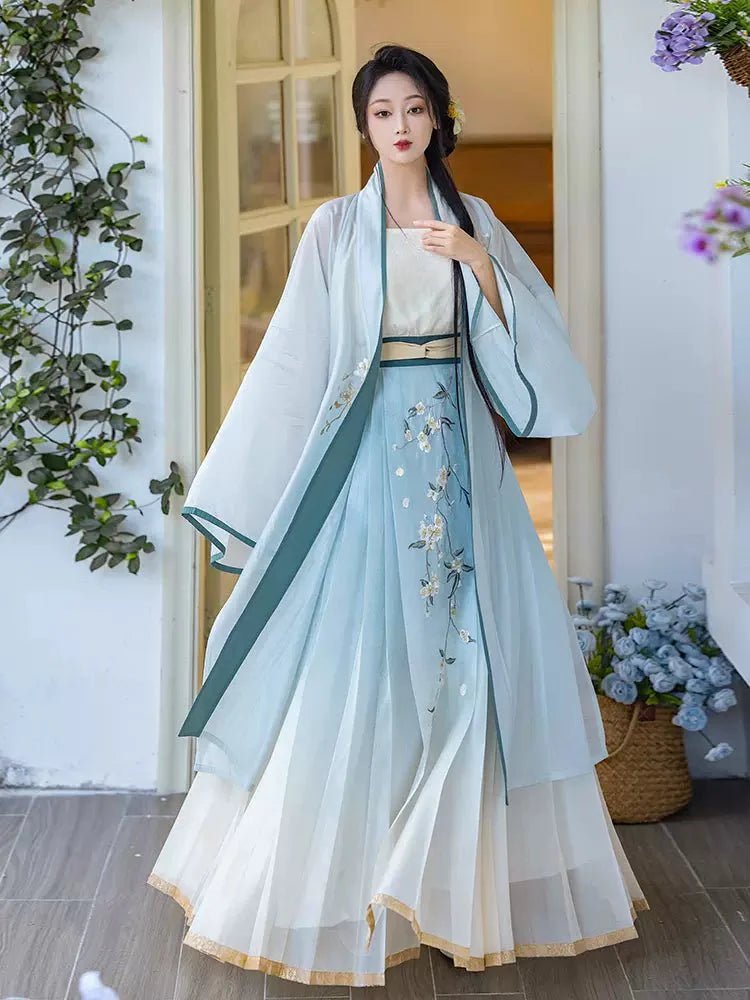Hanfu, the traditional clothing of the Han Chinese, has surged in popularity as a symbol of cultural pride and timeless elegance. For beginners, however, diving into the world of Hanfu can feel overwhelming. From sizing confusion to styling mishaps, newcomers often struggle with where to start. This comprehensive guide will walk you through how to wear hanfu confidently, master hanfu accessories, and nail hanfu sizing tips—all while avoiding common pitfalls. Let’s begin your journey into this beautiful tradition!
1. Understanding Hanfu: A Quick Cultural Primer
Before diving into styling, it’s essential to appreciate hanfu’s historical roots. Hanfu refers to a system of garments worn for over 3,000 years, characterized by flowing silhouettes, cross-collars, and intricate draping. Key styles include:
-
Ruqun (襦裙): A blouse-and-skirt combo popular in the Tang Dynasty.
-
Aoqun (袄裙): A jacket-and-skirt set from the Ming Dynasty.
-
Shenyi (深衣): A one-piece robe with a wrapped design.
-
Zhiduo/Changshan (直裰/长衫): Long robes often worn by scholars.
Pro Tip: Research the era or dynasty that resonates with you—this will guide your style choices!
2. How to Choose the Right Hanfu: Sizing and Style
Hanfu Sizing Tips for Beginners
Unlike Western clothing, hanfu prioritizes loose, flowing fits. Here’s how to get sizing right:
-
Measure Key Areas:
-
Bust/Chest: Measure the fullest part.
-
Waist: Measure your natural waistline.
-
Sleeve Length: From shoulder to wrist.
-
Garment Length: Depends on the style (e.g., ankle-length for robes).
-
-
Understand "One Size Fits Most"
Many hanfu sellers use unisex sizing. Check size charts carefully, and opt for adjustable designs (e.g., tie closures) if you’re between sizes. -
Fabric Matters:
Lightweight fabrics like silk or linen drape better for a graceful look. Stiffer fabrics may require precise sizing. -
Height Adjustments:
Taller individuals may need custom lengths for robes or skirts to avoid awkward bunching.
Visual Guide: [Insert infographic showing measurement points]
3. Step-by-Step Tutorial: How to Wear Hanfu
Basic Ruqun (Blouse + Skirt) Outfit
Tools Needed: Inner garment (Zhongyi), Ru (blouse), Qun (skirt),腰带 (belt).
-
Layer the Inner Garment (Zhongyi):
-
Wear a plain, lightweight underrobe to maintain modesty and comfort.
-
-
Put on the Ru (Blouse):
-
Cross the left side over the right (右衽 youren), a key cultural detail. Never cross right-over-left—this symbolizes mourning.
-
Secure with inner ties.
-
-
Attach the Skirt (Qun):
-
Wrap the skirt around your waist, overlapping the front panels.
-
Tie securely at the side or back.
-
-
Add the Belt (Yao Dai):
-
Place the belt over the skirt’s waistband. Adjust tightness for comfort.
-
-
Adjust Proportions:
-
Ensure the blouse slightly peeks under the skirt for a balanced look.
-
Video Tutorial Link: [Embed a short clip demonstrating Ruqun styling]
4. Hanfu Accessories Guide: Elevate Your Look
Accessories are the soul of hanfu styling. Here’s how to master them:
Essential Hanfu Accessories
-
Hairpieces (发饰):
-
Bixi (蔽膝): A decorative forehead pendant for Tang-style outfits.
-
Hairpins (簪子): Choose jade or floral designs for elegance.
-
-
Belts and Sashes:
-
Yao Dai (腰带): A wide embroidered belt for structure.
-
Pei (佩): Jade pendants hung from the belt for nobility vibes.
-
-
Footwear:
-
Embroidered Silk Shoes (绣花鞋): Match colors to your hanfu.
-
Cloud-Toe Boots (云头靴): Perfect with Ming-style robes.
-
-
Bags and Pouches:
-
Xiuhe Bao (绣荷包): Embroidered pouches for carrying small items.
-
-
Jewelry:
-
Earrings, bracelets, and necklaces in jade or gold to complement your dynasty style.
-
Styling Hack: Less is more! Avoid overwhelming your outfit—pick 2-3 focal accessories.
5. Common Hanfu Mistakes (And How to Fix Them)
-
Wrong Sizing:
-
Problem: Too tight or too short.
-
Fix: Always size up for a relaxed fit, and check garment lengths against your height.
-
-
Incorrect Collar Draping:
-
Problem: Crossing right-over-left (reserved for funerals).
-
Fix: Practice the left-over-right fold until it’s muscle memory.
-
-
Over-Accessorizing:
-
Problem: Clashing colors or too many hairpins.
-
Fix: Stick to a cohesive color palette and prioritize simplicity.
-
-
Ignoring Undergarments:
-
Problem: Visible modern clothing underneath.
-
Fix: Invest in a neutral Zhongyi for seamless layering.
-
-
Fabric Wrinkles:
-
Problem: Cheap polyester creases easily.
-
Fix: Opt for natural fabrics like silk or linen, and steam before wearing.
-
6. Where to Buy Hanfu: Trusted Retailers
-
Taobao/Tmall: Affordable options with detailed size charts (use a proxy service if outside China).
-
Dianping: Check reviews for quality assurance.
-
Etsy: Handmade, customizable hanfu for unique pieces.
-
Local Cultural Societies: Many host hanfu markets or tailoring services,like Hanrong Hanfu.
Pro Tip: Join hanfu communities on Reddit or Facebook for seller recommendations!
7. Final Checklist Before You Step Out
-
✅ Collar crossed left-over-right.
-
✅ Skirt secured without slippage.
-
✅ Accessories harmonize in color and style.
-
✅ Hair styled neatly (try a low bun or braids).
-
✅ Walk with confidence—hanfu is meant to flow!
Conclusion: Embrace the Hanfu Journey
Learning how to wear hanfu is a rewarding way to connect with history while expressing personal style. By mastering hanfu sizing tips, accessorizing wisely, and avoiding rookie mistakes, you’ll soon move from novice to hanfu enthusiast. Remember: Hanfu isn’t just clothing—it’s a celebration of heritage.
Ready to take the next step? Share your first hanfu look on social media with #HanfuBeginner, and inspire others to join the movement!




